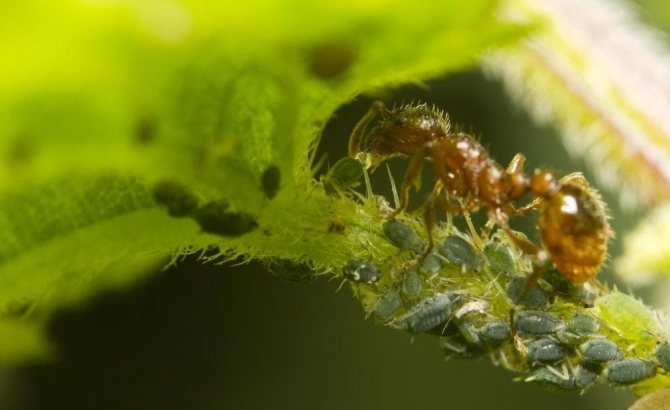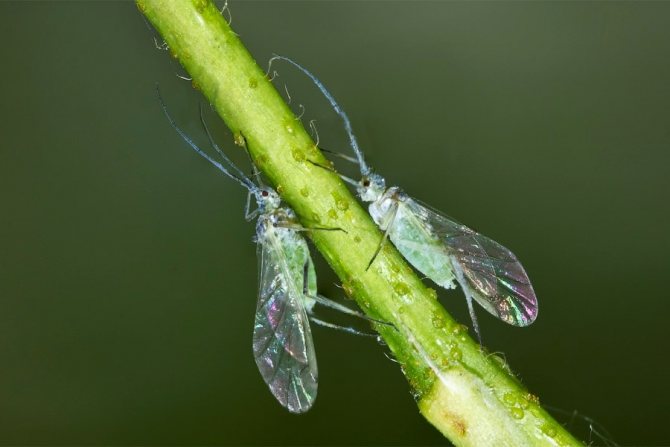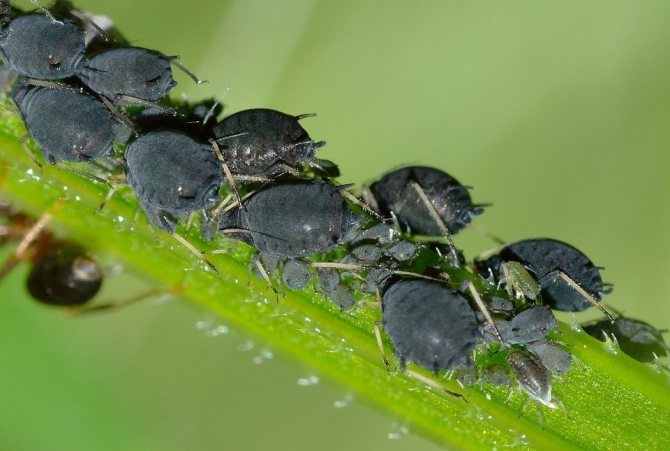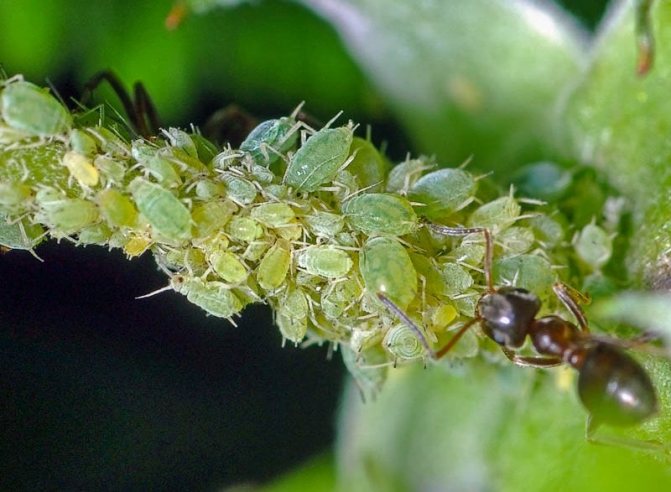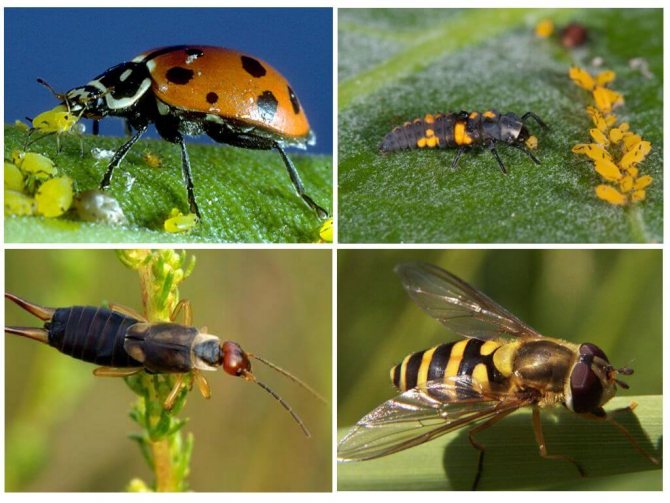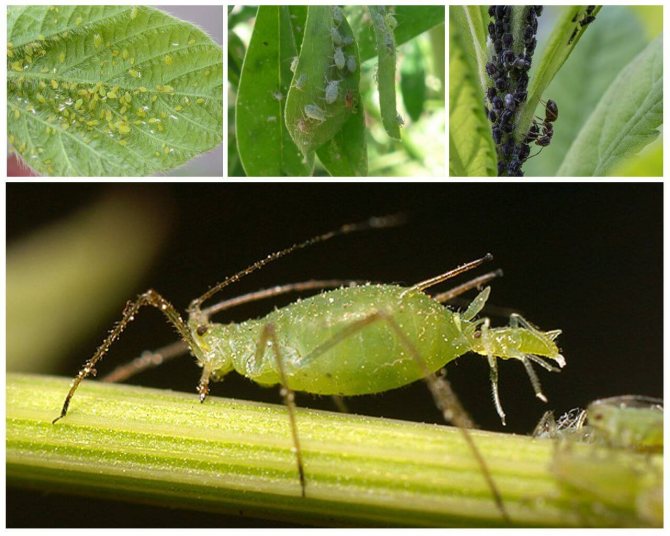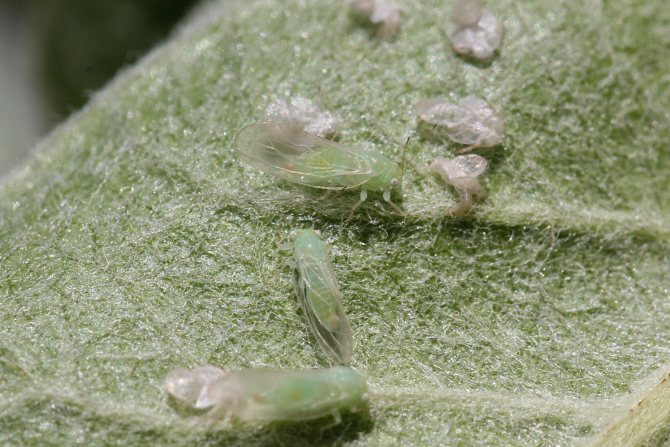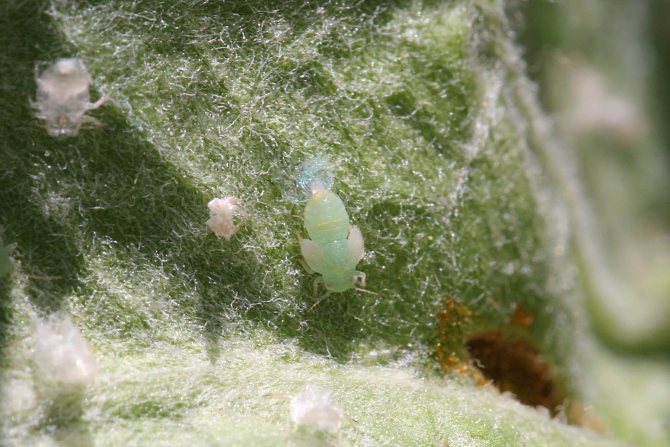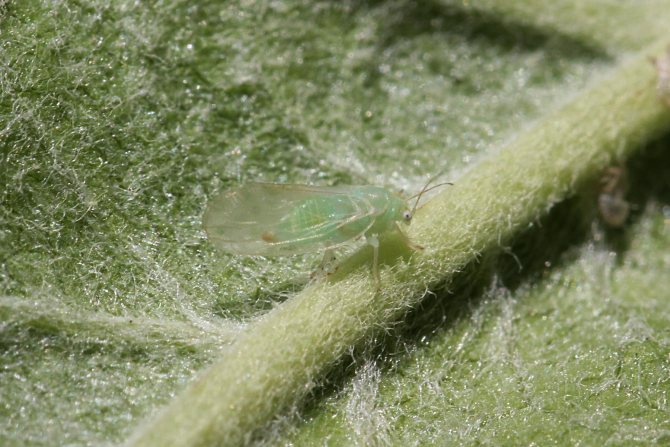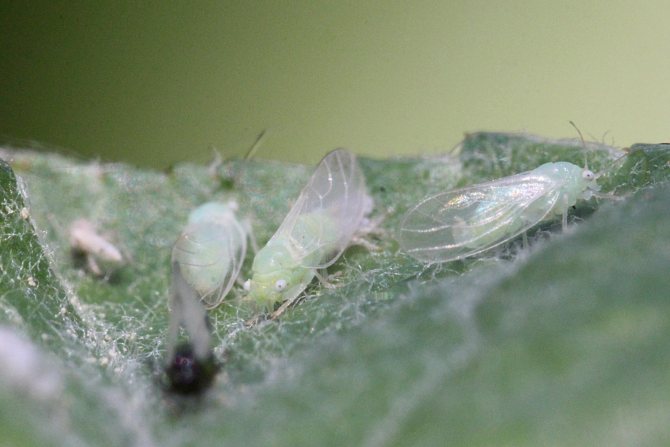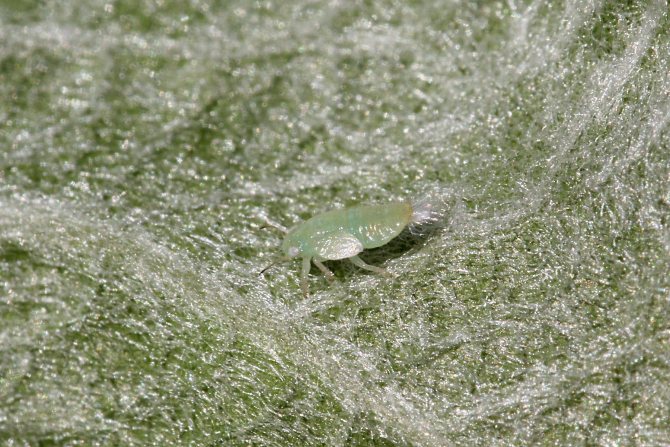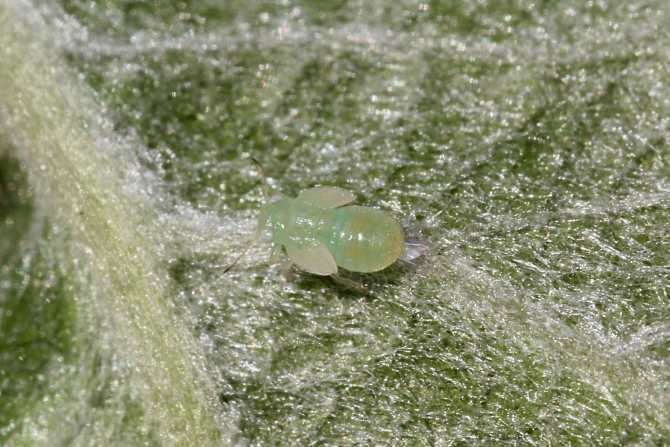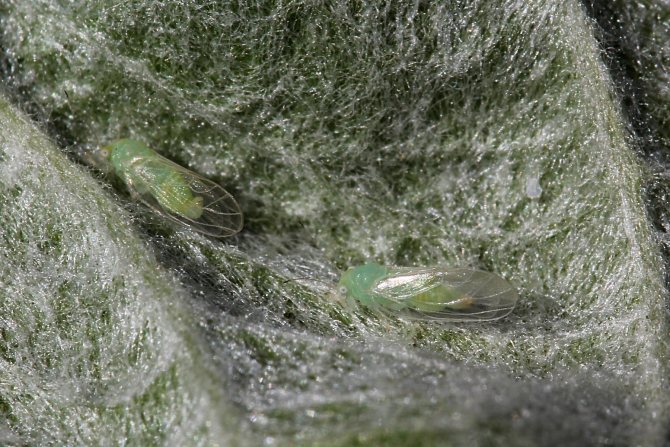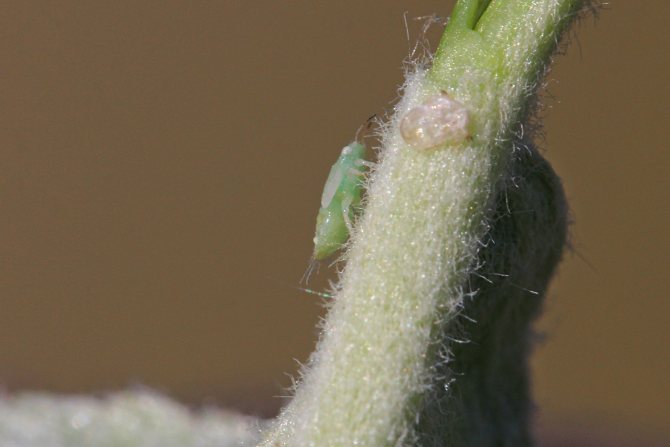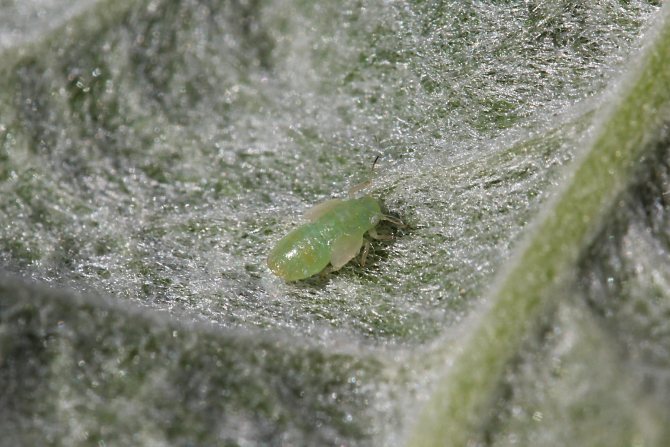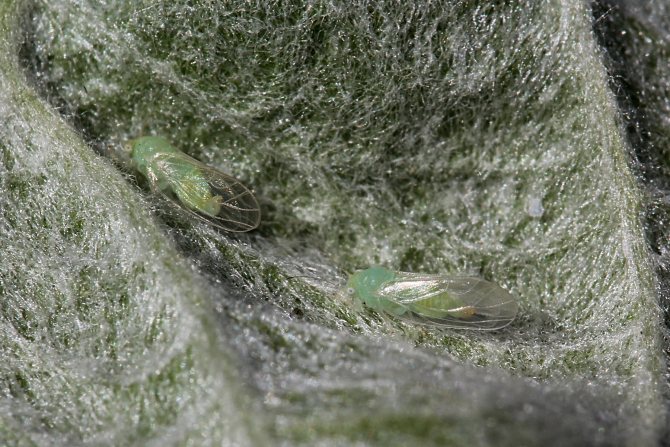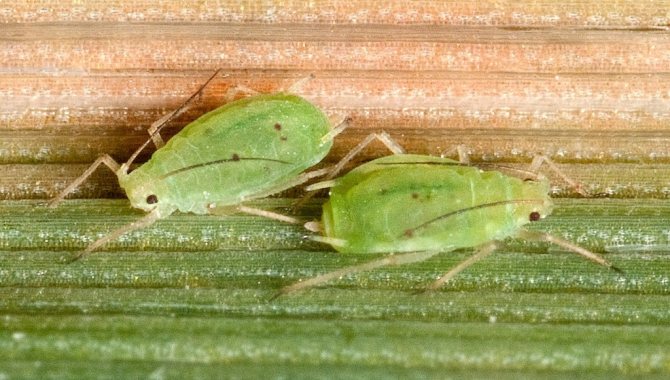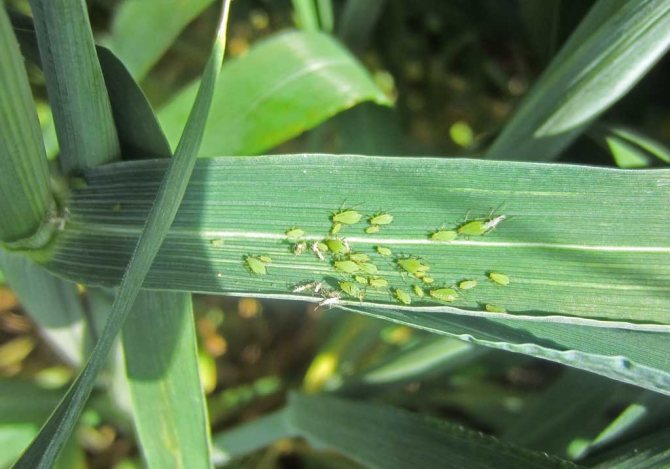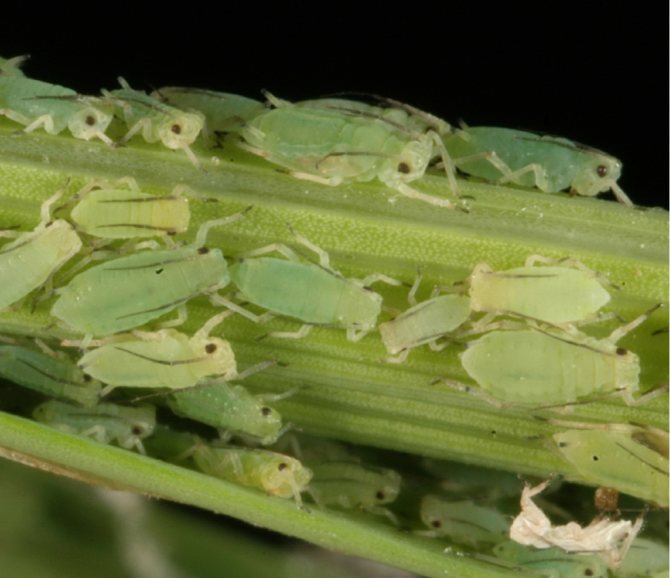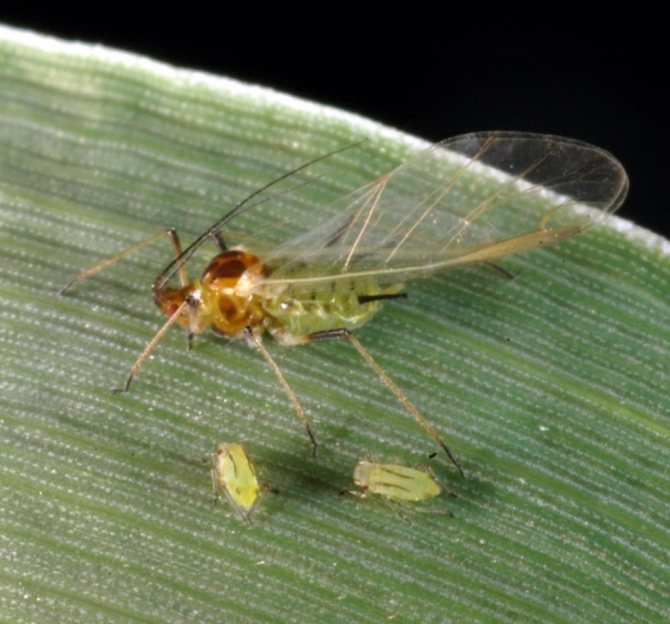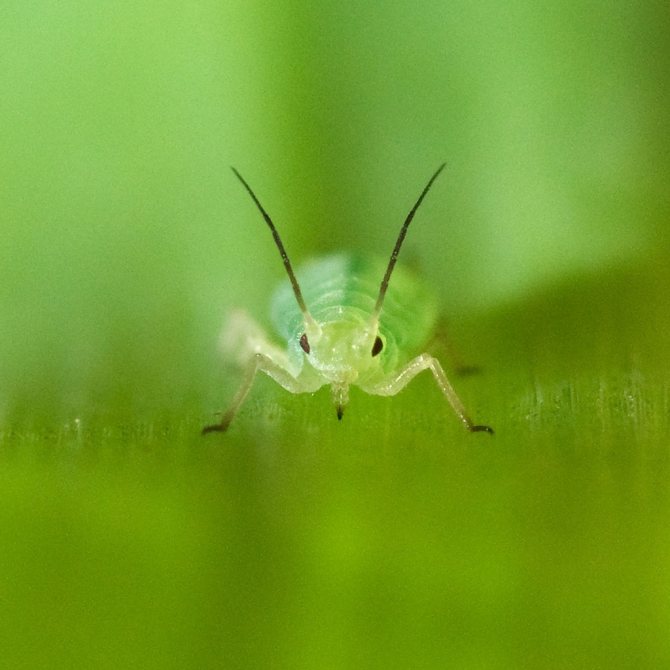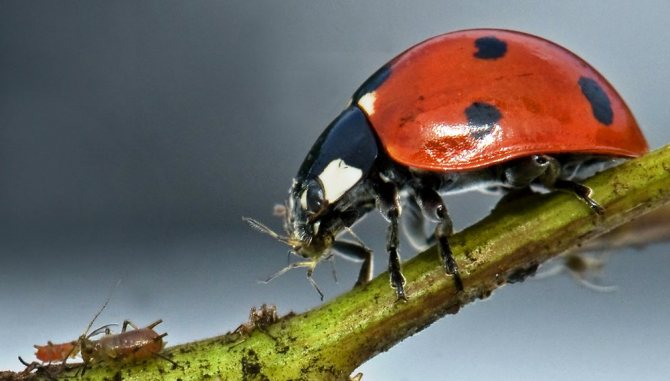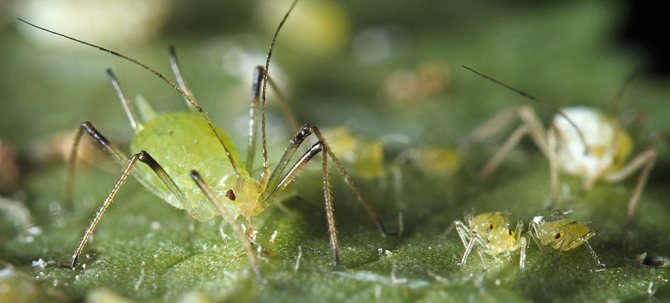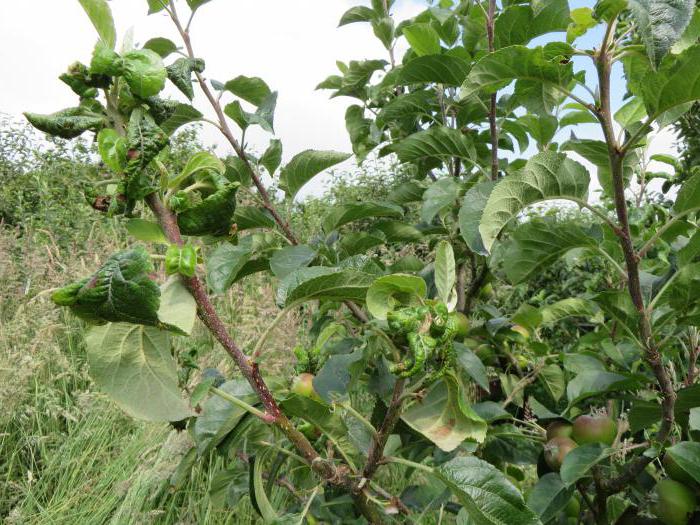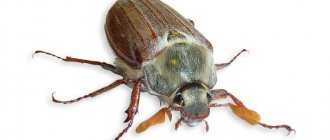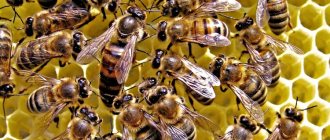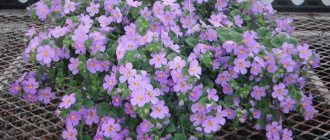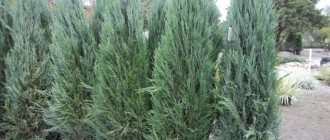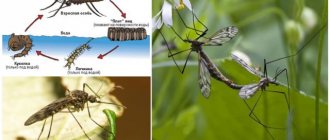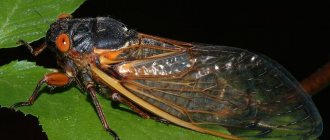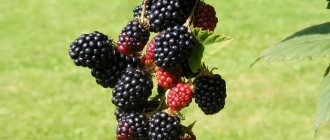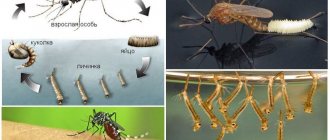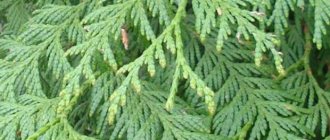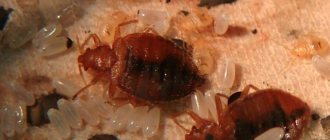Description of appearance
What aphids look like has been seen many times by gardeners, gardeners, flower growers. However, they pay special attention to these pests after the plant begins to wither - yellow leaves, spots, pimples, growths, deformations appear. On the reverse side of the leaf, on young shoots, near the inflorescences, small insects of different colors are found. This is aphid.
The body of an adult is egg-shaped. The size is several millimeters, some species of aphids reach 7 mm. Any kind of aphid has wingless, winged individuals. The first spend their entire life on an infected plant, reproduce offspring non-stop. The latter migrate to other crops, infecting trees, shrubs, flowers, and garden crops. The photo of the aphid is presented below, you can clearly see the structure of the body.
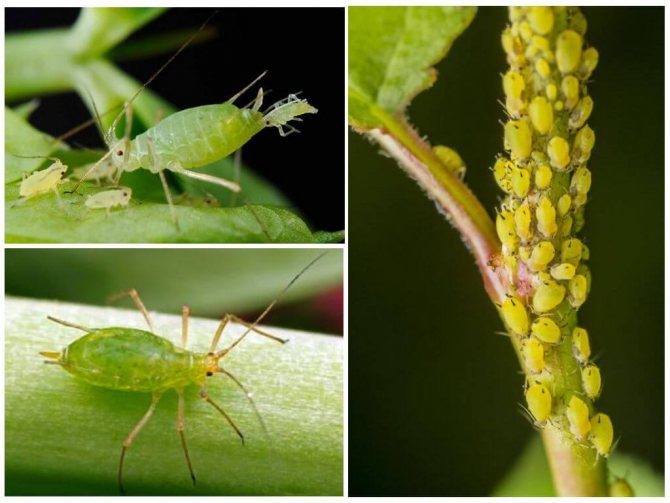
Aphid appearance
Each type of aphid has thin legs, long antennae, well-visible round eyes on the sides of the head. However, all these features are difficult to see with the naked eye. The variety of pests is determined by a large number of the smallest bugs concentrated in one place - on a leaf, a stem.
On a note!
Aphid varieties differ slightly in body shape, size. The most varied color - black, red, green, brown, yellow, beige, etc. The integument of the body is soft, almost transparent. The female lays eggs in autumn. They have a round, oval shape, and do not exceed 1 mm in size.
Features and habitat of aphids
Aphids are small insects, not exceeding a few mm in length. The body of the aphid has the shape of an oval; it is covered with a soft, tuberous translucent shell. With the help of sufficiently long legs, these parasitic insects are able to crawl from one plant to another and even jump.
In each colony of aphids, both wingless and winged individuals are present, each of which plays a specific role in a given population. Moreover, the presence of wings is not determined by gender - both males and females can be winged.
On the frontal part of the head of an adult, special antennae are located, which are responsible for touch and hearing. The eyes have a complex multi-faceted structure; wingless individuals additionally have three simple eyes.
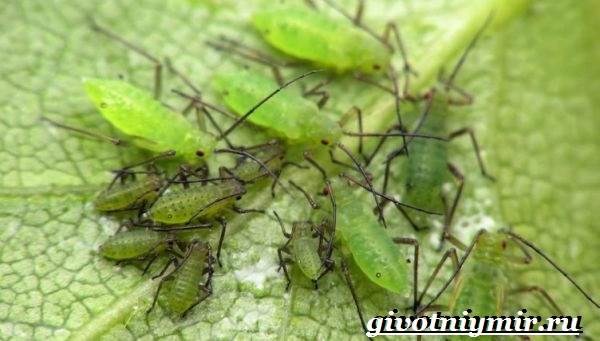

Aphids' compound eyes can range in color from red to black-brown. Surprisingly, aphid's visual perception is an order of magnitude better than, for example, bees. Aphids can even distinguish some colors.
The mouth organ of the aphid is represented by a small proboscis, consisting of 4 segments. With this proboscis, the aphid pierces the integument of the plant and sucks out nutritious juices. There are over 4,000 species of aphids in the world. These insects prefer warm climates with high humidity. Aphids feel great in greenhouses.
Food
What the insect eats, we can confidently answer - plant juices. What kind of plants depends on the type of pest:
- red aphid affects currants;
- black settles on eggplants, peppers, beans, melons, watermelons;
- green loves peas.
Aphids on plants
Aphids are a dangerous pest that causes significant damage to agriculture. Insects extract vital juices from plants, which not only significantly affects fruiting, but can also lead to mummification and death of plants.
In addition, parasites often provoke the formation of various anomalies on plants, for example, gall and gall-like formations.
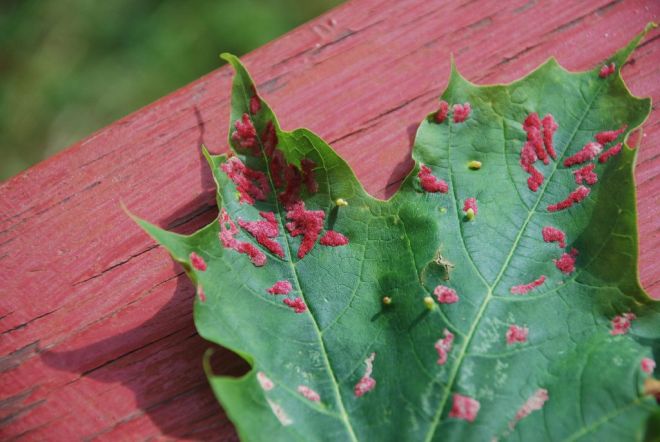

Gauls on a maple leaf
Life cycle
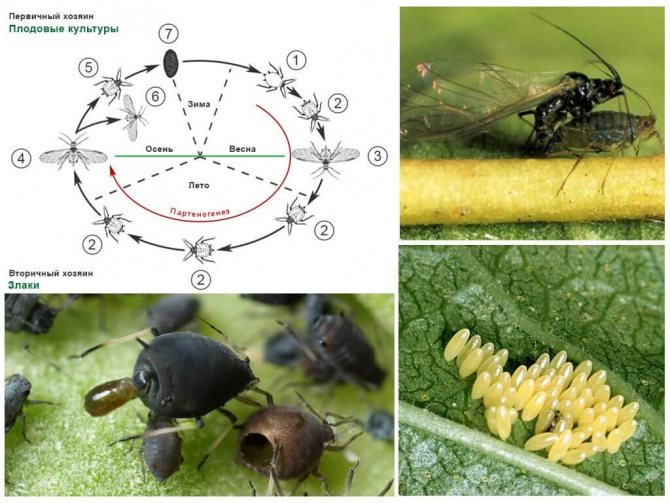

Life cycle of aphids
Features of the life cycle depend on the species of aphid. In one family, there are sexual, asexual generations. Wingless females emerge from the egg in early spring. They parasitize the plant where they hibernated at the egg stage. In the spring, under favorable conditions, the female aphid, reproducing parthenogenetically, gives birth to virgin females, whose task is to reproduce several more generations of their own kind.
How many aphids live under favorable conditions - about a month. During this time, it reproduces several thousand larvae. For the entire warm season, on average, 4 generations are replaced. Closer to autumn, a flying aphid appears. These are sexually mature individuals capable of migrating to other plants. Each species chooses its own - trees, shrubs, weeds, garden crops, flowers.
Aphid damage
Aphids do a lot of harm. New colonies form on the bottom of the plant. Insects release toxins that change the shape of the plant's organs. Young shoots, buds and flowers are affected first.
If the aphid colony has a large number, then the growth of the plant stops. Spots or a yellow mesh form on the leaves, the secretions pollute the plant and prevent the absorption of color. Black fungus or other types of mold may develop. The shoots that struck the aphid are weakened and die in winter.
REFERENCE: it is worth monitoring the condition of the leaves, the formation of tumors or ulcers.
Features of behavior
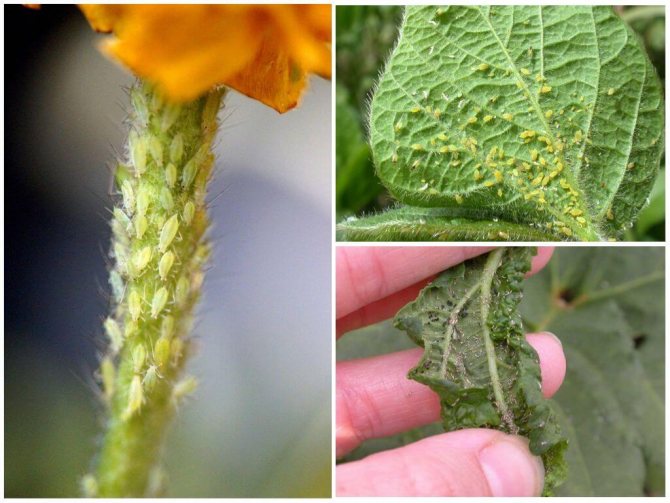

Aphid habitat
All types of aphids love warm, humid climates. Under this condition, up to 19 new generations appear per season. You can meet insects in the garden, in the garden, greenhouses, on indoor plants. Flowers are infested with soil, which is poured into a flower pot or through open windows without preliminary treatment.
Insects hide from direct sunlight, preferring to live on the back of the foliage. This behavior is also due to the fact that aphids have natural enemies. Ladybugs, lacewings, hover flies feed on small pests. To get rid of aphids on the land, their natural enemies are attracted.
Who eats the pest and is the most dangerous devourer?
Obligate group of insects
Insects belonging to this group are effective biological weapons against aphids, since they are the main food source for this group of predators.
ladybugs
The main helpers of all gardeners are ladybugs and their larvae. They belong to the order of coleoptera or beetles, are natural enemies of aphids and are able to eat their colonies from spring to late autumn. The daily diet of one individual consists of approximately 50 aphids.
Especially quickly and in large quantities, the larvae of ladybirds eat aphids, which are larger than adult beetles and do not look like them at all (flatter, gray-black in color with red-yellow spots on the sides). They are able to swallow from 70 to 100 adult aphid flies and their larvae per day.
In nature, ladybugs live together with a colony of aphids, on which they feed. To get rid of the pest in greenhouses, special technologies are used using the larvae and imago of a ladybug, and when protecting indoor plants, various methods of attracting beetles are effective (how to deal with aphids on indoor plants?).
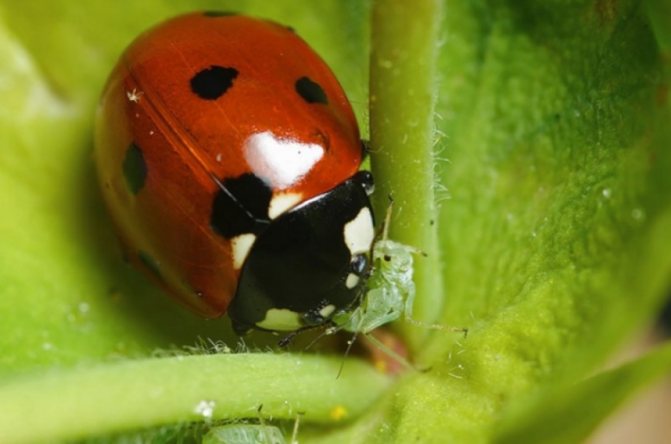

Lacewings
Insects with transparent wings, light greenish in color, having large, golden eyes with a shimmer. The larvae of lacewings reach one and a half centimeters in length, have a warty body with sparse hairs.
Females lay eggs next to aphid colonies, and sometimes directly in them. Adults prefer to eat plants. But the larvae of the lacewing are predators, they eat aphids, its larvae. They also kill other pests of fruit and vegetable crops. The time of activity of these predators is night.
The lacewing is invaluable in the fight against aphids, experts recommend that you add this fly to plots or greenhouses, if it was not previously seen there.
When attracting an insect, it is advised to use tansy and cumin.
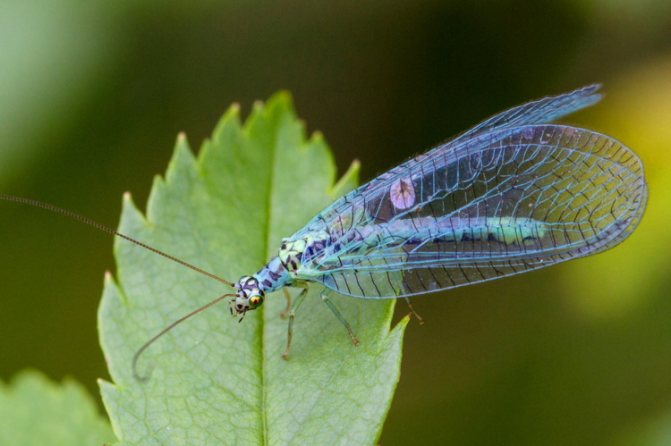

Sand wasps
Adults of sandy or "burrowing" wasps feed on flower nectar, plant sap, and sweet secretions of aphids. Taking care of the offspring, these insects build nests and store food for their larvae, which can be aphids, its eggs, larvae, as well as spiders, flies, caterpillars, butterflies and others. Each type of wasp prefers to feed on a certain type of pest, aphids are hunted by the wasp subfamily Pemphredoninae.
The fight against aphids with the help of wasps is not widely used due to the danger of bites and their consequences for humans, but if you need to attract them to your site, then for the aspen family you will need to arrange a comfortable place of residence - a nest.
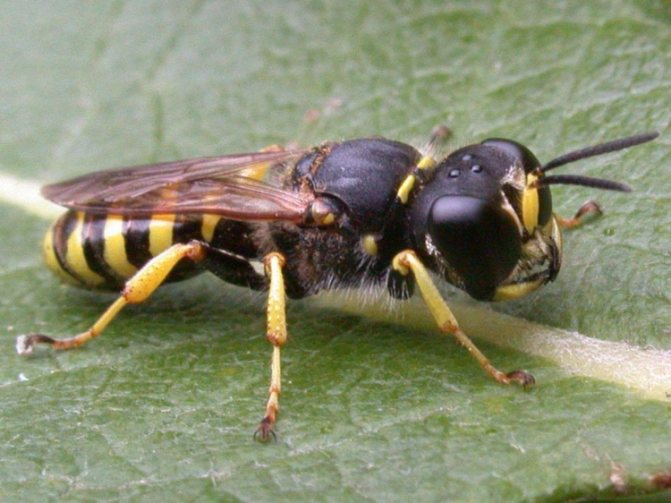

Optional
For such insects, aphids are not the basis of their diet; their destruction occurs whenever possible. This group includes:
- earwigs;
- crickets;
- ground beetles;
- some types of spiders.
Earwigs
An adult earwig is capable of destroying up to a hundred aphids in one night. This is a very voracious insect with a long flat body, wings and two tails (cerci), which are needed to capture prey. The earwig runs very fast and rarely flies; in food it prefers aphids and ticks.
It can feed on other pests, as well as plants, which is why they prefer to get rid of earwigs in their backyards. And in order to attract the earwig to the affected plant, you should put a pot of wood shavings next to it, where the insect will hide during the day.
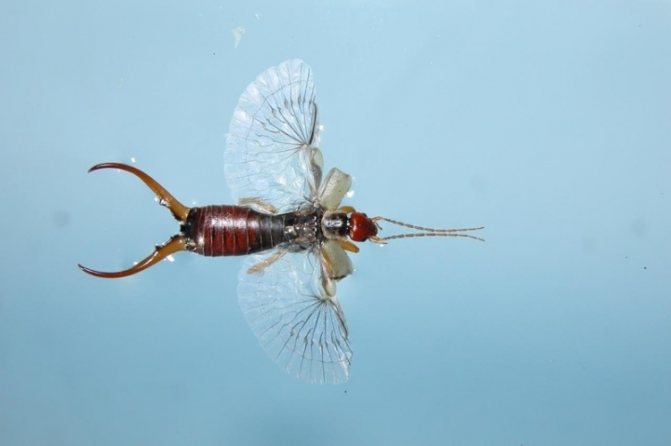

Crickets
Of all the species, the field cricket is the most common. It is an omnivorous insect that feeds on both plant food and small insects and invertebrates, including aphids, and its larvae. In food, he prefers plants, as a result of which he is considered a pest insect and an unwanted guest in the garden.
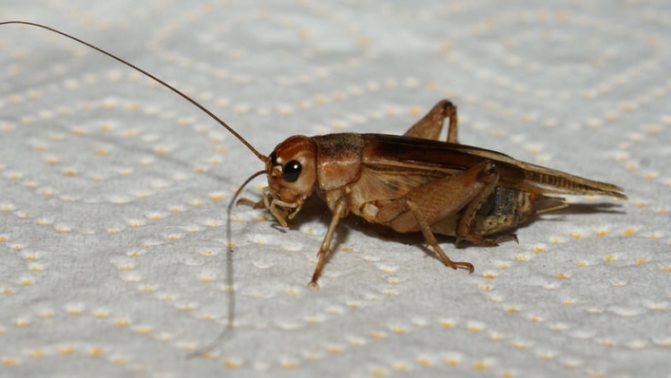

Ground beetles
Nocturnal predators belong to the order of beetles. The body length of the ground beetle reaches 60 mm, and the color varies from dark to metallic. Differs in a varied diet, can eat aphids, slugs, snails, worms. The more pests in the garden, the more attractive it is for the ground beetle.
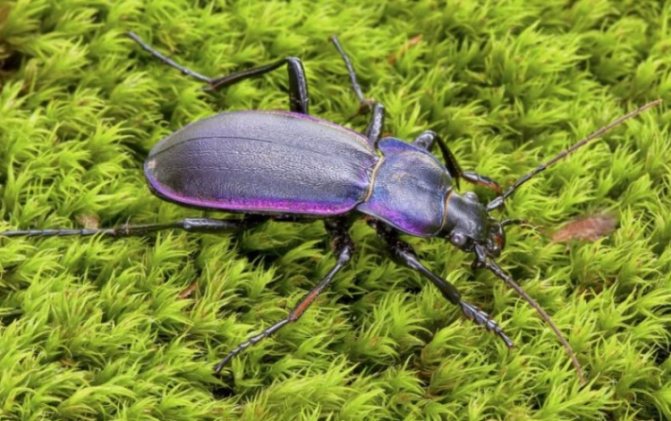

Spiders
Spiders are real plant defenders, they kill not only aphids, but also other dangerous insects:
- leaf rollers;
- springtail;
- small slugs;
- snails;
- bedbugs.
Due to their way of eating prey, spiders can find pests both in the soil and in the deciduous layer.
Basically, they eat winged aphids, which are entangled in the cobweb, but do not disdain and fell to the ground.
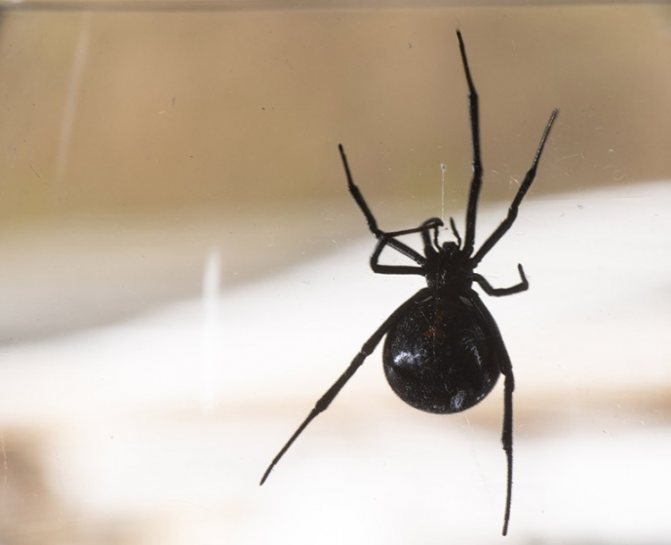

Sabotage
A large colony of pests significantly damages the leaves and weakens the plant. Infection, fungi develops on the affected leaves, the culture begins to hurt. But even without this, cultures deprived of juice cease to grow and develop. Leaves are deformed, curled, turn black, fall off, young shoots dry up, inflorescences fall off, fruits are not formed. Seedlings die, fruit trees, berry bushes cease to bear fruit or yield significantly decreases, forcing gardeners to get rid of pests.
Insect damage
Aphids often settle on domestic plants and cause serious harm. She sucks juice from different parts of them. The result is deformation of shoots, twisting of leaves, slowing down of growth. The yield is significantly reduced. It is difficult for a diseased plant to winter. Aphids kill young growth.
Aphids are capable of carrying various viruses. Black soot dew causes significant damage to gardeners.
Honeydew or honeydew appears on the plants. These are waste products of harmful insects. The plant's breathing is hampered by this sticky liquid. Various fungi appear on the surface.
There are many ants near diseased plants, attracted by honeydew. Insects live in symbiosis. Ants protect pests, and in return they receive a sugar-containing liquid.
Control methods
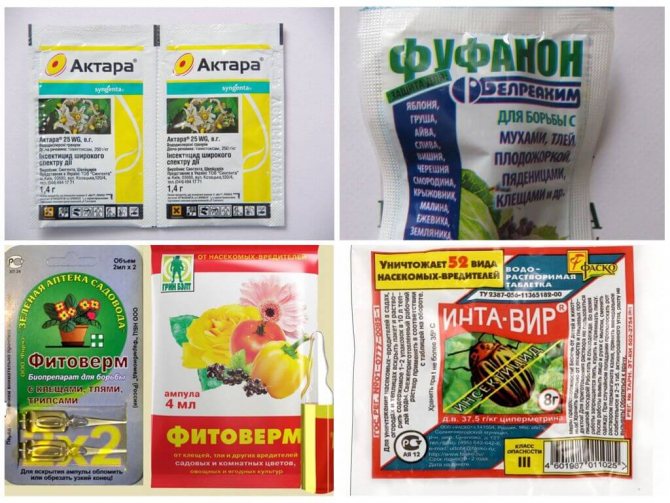

Pest control chemicals
To prevent contamination of the land in early spring, weeds are burned even in late autumn, the affected branches are broken off, the bark with pest eggs is cut off, and the earth is dug up. In early spring, it is recommended to add wood ash to the soil. The active components of the ash get into the sap of the plants, making it bitter and unattractive to insects.
Before the leaves bloom, it is allowed to treat the trees with insecticidal substances. The effect of the drug lasts up to 2 months. By the time the fruit ripens, the poison is neutralized. Apply Aktellik, Aktara, Karbofos, Fufanon. If infection occurs during flowering, fruit ripening, folk remedies or phytopreparations are used.
Among folk remedies, solutions of ammonia, table vinegar, ash, tobacco, tar or laundry soap are considered effective. And also tinctures of garlic, onion husks, tansy, wormwood, pine. To scare off pests in the garden, in the garden, flower beds, it is recommended to plant calendula, marigolds, peppermint, chamomile. From phytopreparations Fitoverm, Iskra bio, Tanrek, Strela are in special demand. The effect occurs within a week, the effect lasts about 14 days.
Prophylaxis
Aphids do not tolerate the odors of some plants. These include onions, garlic, chamomile. A gardener can plant these plants as a preventive measure. It is also possible to carry out a red herring. To do this, plant on the site plants that attract aphids: nasturtium, kosmeya, poppy, mallow, viburnum and linden.
There are several ways to prevent:
- to clean the land plot from foliage and grass in the near-trunk circles in the fall;
- cut out tops and root growth in time;
- partially destroy anthills during the spring and summer. Complete destruction is impractical, since ants are one of the only pollinators in cold and windy times;
- use whitewash for trees;
- properly care for plants and berry crops;
- for indoor flowers, use special processing agents.
Harmful insects are always unpleasant in the garden. Aphids have a large number of varieties of their kind. The advantage of each species is the rapid reproduction and rapid growth of the population of colonies.

